States
AlaskaThis project will reconstruct three culverts within the Copper River Watershed in Alaska. Removal of these barriers promotes passage for Chinook and Coho salmon, Dolly Varden, Arctic grayling and longnose sucker. Replacement stream crossings will promote a more natural ecosystem, improve climate resiliency, and restore aquatic connectivity to upstream and wetland habitats. Stream crossings that ensure year-round passage for fish also greatly reduce the likelihood of catastrophic structure structure
Something temporarily or permanently constructed, built, or placed; and constructed of natural or manufactured parts including, but not limited to, a building, shed, cabin, porch, bridge, walkway, stair steps, sign, landing, platform, dock, rack, fence, telecommunication device, antennae, fish cleaning table, satellite dish/mount, or well head.
Learn more about structure failure, risks to human health and safety, environmental damage, and loss of access to emergency services and subsistence resources.
Project Quick Facts:
| Project Status | In Development |
| Location | AK, Copper River Census Area |
| NFPP Project Funding | $525,000 |
| Restoration Techniques | Culvert Replacement |
| Accomplishments | 8 Stream Miles Reopened, 18 Acres Reopened |
| Partner Project Lead | Copper River Watershed Project and Copper River Native Association |
The National Fish Passage Program combines technical expertise with a track record of success.
Implemented primarily through the Service's Fish and Wildlife Conservation Offices, the National Fish Passage Program provides financial and technical assistance to partners across the country. Since 1999, the program has worked with over 2,000 local communities, Tribes, and private landowners to remove or bypass over 3,400 barriers to fish passage fish passage
Fish passage is the ability of fish or other aquatic species to move freely throughout their life to find food, reproduce, and complete their natural migration cycles. Millions of barriers to fish passage across the country are fragmenting habitat and leading to species declines. The U.S. Fish and Wildlife Service's National Fish Passage Program is working to reconnect watersheds to benefit both wildlife and people.
Learn more about fish passage and reopen access to over 61,000 miles of upstream habitat for fish and other animals. Staff have expertise in fish migration and biology as well as financial, engineering, and planning assistance to communities, Tribes, and landowners to help them remove barriers and restore rivers for the benefit both fish and people.
Fish passage project proposals can be initiated by any individual, organization, government, or agency. However, proposals must be submitted and completed in cooperation with a Fish and Wildlife Conservation Office. (Please note that fish passage projects being used for federal or state compensatory mitigation or required by existing federal or state regulatory programs are not eligible for funding through the National Fish Passage Program.)
CONTACT A FISH PASSAGE COORDINATOR IN YOUR AREA TO GET STARTED.


